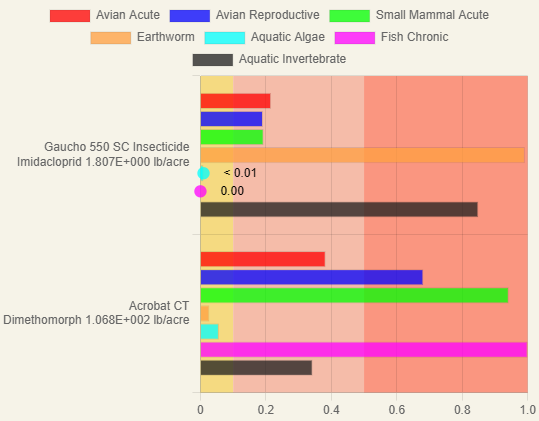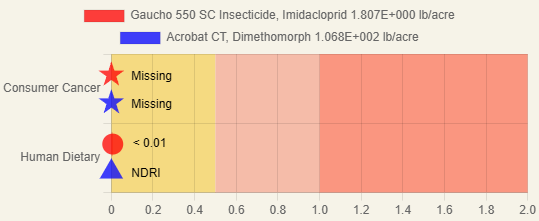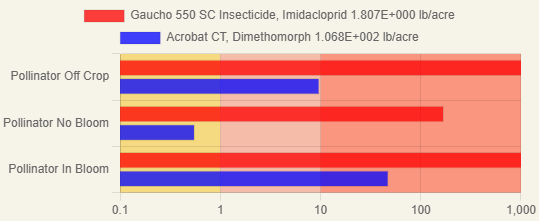
The Pesticide Risk Tool (pesticiderisk.org) is designed as a probabilistic risk ranking tool rather than an absolute measure of environmental harm. It is strongest in its ability to compare pesticide options relative to each other and to evaluate the impact of changing application rates and methods, and using alternative, lesser risk products. For some of the indices (see descriptions below), field results have been used in order to calibrate the risk scores against actual ecological damage.
Image one (below) shows a risk summary for two products grouped by risk index for the Environmental Indices risk chart.

Image 1 (risk scores grouped by index)
The risk indices are shown on the y-axis, while the risk index scores are shown on the x-axis. The bars indicate the risk scores for each pesticide application in each index. The legend on top shows which color represents which application. Also, by hovering your mouse over a bar, you can display which product the bar represents.
Image two (below) shows a risk summary for the same two products but this time grouped by product.

Image 2 (risk scores grouped by product)
The products are shown on the y-axis, and the risk index scores are shown on the x-axis. The bars indicate the risk scores for each index. The legend on the top shows which color represents which risk index.
The Pesticide Risk Tool calculates potential risks of pesticide applications to the natural environment (except for pollinators, which are considered separately) in the form of seven Environmental Risk Indices. The seven indices cover a broad range of organisms potentially affected by pesticide applications. The risk index scores for the environmental indices range from zero to one and are probability scores:
High risk scores (>0.50) indicate a high probability that a pesticide application will have negative impact on an area of concern in the environment. Risks can be reduced in numerous ways, some of which can be measured in the Pesticide Risk Tool. The Pesticide Risk Tool can measure the reduction in risk caused by a reduction in the pesticide application rate and the reduction in risk caused by switching to a lower-risk pesticide product.
Other mitigation factors such as buffer zones or timing of the pesticide application are not taken into account by the tool’s risk calculation. Also, site specific factors such as the proximity to water bodies for aquatic indices will also affect the potential impacts of the pesticide application, but are not factored into the calculation. For example, if a pesticide is applied to an area that is not near a water body, the actual aquatic risk will be lower than indicated by the risk scores.
University extension experts and crop advisors can provide more extensive options for mitigation based on your location and crop.
The following represent potential risks to workers and/or bystanders that are exposed to pesticides. Scores given are hazard quotients with scores greater than 1.0 representing a predicted exposure to a concentration greater than the determined threshold. This does not mean that harm is certain, rather it means that the estimated exposure could cause harm to vulnerable members of the population.

Image 3 (Human Bystander risk scores grouped by index)
High risk scores indicate a high possibility that a pesticide application will have negative impact on humans working in and/or living nearby the treated fields. Risks can be reduced in numerous ways, some of which can be measured in the Pesticide Risk Tool. The Pesticide Risk Tool can measure the reduction in risk caused by a reduction in the pesticide application rate or by switching to a lower-risk pesticide product.
Other mitigation options are not taken into account by the tool's risk calculation. For example, for dermal indices, the tool assumes that workers re-enter the treated field immediately after the re-entry interval required on the pesticide label has passed. Increasing the interval between application and workers re-entering can reduce the hazard. The inhalation index is for humans near the field; ensuring that pesticides are not applied at times when groups could be exposed (e.g., at school break times or when workers are in adjacent field) can mitigate risk.
University extension experts and crop advisors can provide more extensive options for mitigation based on your location and crop.
The following represent the relative chronic risk presented by pesticide residues on or in food.
Pesticide dietary risk from a single pesticide in one food is determined from the level of exposure in a given day and the pesticide’s toxicity. Pesticide exposure is determined by: (1) the estimated milligrams of pesticide per kilogram of food, and (2) how much food is consumed by the person. A person’s age, health status, body weight, and genetics also can markedly alter risk levels.

Image 4 (Consumer Dietary risk scores grouped by product)
The purpose of the DRI is to highlight pesticide dietary risk reduction options for farmers, regulators, and consumers. The consumer risk indices bring attention to the potential hazard of certain pesticide residues to consumers. The Pesticide Risk Tool can measure the mitigation effect on changing the pesticide used or for the consumer cancer the application rate. The Pesticide Risk Tool does not take into account other mitigating factors that may reduce dietary risks. For example, the following use patterns may greatly alter expected, average residue levels in the harvested crop and are not reflected in tool's output:
University extension experts and crop advisors can provide more extensive options for mitigation based on your location, crop and pest issue.
This calculates the risk of pollinators such as wild or managed bees accumulating a lethal dose of a specific pesticide over a one-day period. Note that sub-lethal, chronic or reproductive effects are NOT considered, although these may be important also. The index consists of three separate sub-indices with their own separate scores:

Image 5 (Pollinator risk scores grouped by index)
Off-crop score: The risk score to pollinators foraging outside of the crop area (e.g., field borders or neighboring fields) at the time of application. Pollinators are exposed entirely through pesticide drift – primarily through direct contact with the pesticide or on the pollen and nectar on which they forage.
Crop in bloom score: The risk score to pollinators foraging in the crop proper when this crop is in bloom. The risk score will be low or nil if the crop is deemed not to be attractive to pollinators. Please note that the presence of flowering weeds in a crop deemed unattractive to pollinators will lead to a serious underestimate of actual risk. Pollinators are exposed primarily through direct contact with the pesticide or on the pollen and nectar on which they forage. Please note that some pesticide labels prohibit applications when the crop is in bloom. Always follow the pesticide label. The tool's risk calculations assume pesticide label requirements are followed.
Crop not in bloom score: The risk-score to pollinators foraging in the crop proper when this crop is not in bloom even if the crop is deemed attractive to pollinators. Pollinators are exposed solely through the systemic activity of pesticides and eventual uptake in pollen and nectar. Please note that if there are flowering weeds in the field at time of spray, this score will greatly underestimate the true risk to pollinators.
The Pesticide Risk Tool can measure the reduction in risk caused by a reduction in the pesticide application rate and the reduction in risk caused by switching to a lower-risk pesticide product. The timing of an application can greatly reduce the risk, which will be evident either by moving the dates of pesticide applications or if the bloom dates are not known, comparing the risk scores for ‘crop in bloom’ and ‘crop not in bloom’.
Since the ‘off-crop’ risk is dependent on drift from treated fields, changes in application method or pesticide formulation are captured as mitigation efforts in the tool. Taking other measures to reduce drift will reduce the expected impact on pollinators. Drift-reduction measures are not yet captured in the tool.
Any high ‘crop not in bloom’ risk scores may also be mitigated by switching to a pesticide with lower systemic activity.
University extension experts and crop advisors can provide more extensive options for mitigation based on your location, crop and pest issue.
Not all indices apply to all growing conditions. Pesticide applications in greenhouses, for example, do not generate the same risks as applications in less controlled environments.
For most greenhouse operations, pesticide pathways to surface water, air and soil outside of the greenhouse will be limited due to reduced potential for drift and runoff. Risks to workers in adjacent areas, aquatic organisms, earthworms and other terrestrial invertebrates and birds will be reduced.
Potential exposures from disposal of contaminated growing media or plant material should be considered. Worker and consumer risk indices may also require special consideration for greenhouse environments due to difference in pesticide degradation.
The Pesticide Risk Tool will incorporate automatic consideration for greenhouse environments and fumigation in the future.
In some cases, the Pesticide Risk Tool will not have enough data required to make a risk calculation for a given index. A risk index could fail to calculate because we are missing the necessary physical and chemical properties (e.g. foliar half-life) for the active ingredient or because we are missing the necessary toxicity values for the end point of concern. If a risk bar is present, or a number is given (e.g. 0.00, or <0.01), then a calculation was made. In cases where no calculation is made, a risk score may be replaced by one of the following warnings or pass codes, indicating presumed low risk.
| The Risk Summary Legend | |
|---|---|
 0.00 0.00
|
Risk index score is 0.00 |
 <0.01 <0.01
|
Risk index score is less than 0.01 |

|
Insufficient data for a risk calculation |
 AB AB |
Repeated use of this antibiotic in the same field or block can select for antibiotic resistant bacteria. Contact regional disease control specialists in the event of slipping product performance, to determine if resistant phenotypes have emerged. |
 COR COR |
This pesticide is highly corrosive by the inhalation route (DANGER). Avoid inhalation of fumes. |
 COR1 COR1 |
Highly corrosive chlorine gas formed on contact with water (DANGER). Avoid inhalation of fumes. |
 COR3 COR3 |
This pesticide is highly corrosive to skin and eyes. |
 LE LE |
Low exposure assumed for this exposure route - no calculations were made |
 LEH LEH |
Low exposure and low hazard assumed for this exposure route - no calculations were made |
 LEHDR LEHDR |
Low exposure and hazard assumed - PDP did not test for this active ingredient in this crop |
 LH LH |
Low hazard for this exposure route - no calculations were made |
 LHDRI LHDRI |
Low hazard assumed - PDP did not test for this active ingredient in this crop |
 N10 N10 |
This pesticide is highly acutely toxic (DANGER). Although it may not be prone to evaporation and vapor drift, spray drift can pose a serious inhalation hazard. |
 N11 N11 |
This pesticide is highly acutely toxic (WARNING). Spray drift can also pose an inhalation hazard. |
 N12 N12 |
This pesticide is highly acutely toxic (WARNING). Although it may not be prone to evaporation and vapor drift, spray drift can pose an inhalation hazard. |
 NDA NDA |
Human toxicity data not available for this pesticide. |
 NDRI NDRI |
PDP tested for this active ingredient and no residue was found |
 NPDP NPDP |
PDP has not tested this crop for residue. |
 NIC NIC |
Active ingredient not identified as carcinogenic by the Pesticide Research Institute in 2016 |
 QA QA |
No data; no assessment |
 S1DRI S1DRI |
PDP did not test for this active ingredient in this crop |
 NPDP NPDP |
PDP has not tested this crop for residue. |
 W1 W1 |
Rodenticides are extremely toxic to vertebrates. The key to safe use of rodenticides is exclude all but the target species from the bait through the use of efficient bait boxes. Dead rodents should also be disposed of in a way that will make it impossible for scavengers to find. |
 W2 W2 |
Although standard toxicity data are lacking, this material is known to be a strong irritant and toxic by ingestion or inhalation |
 W3 W3 |
The use of all copper products lead to an accumulation of copper in the soil which kills all earthworms. This can have negative consequences on disease management. |
 W4 W4 |
Oils do not represent a toxicological risk but the consequences of fouling of bird feathers has not been assessed |
 W5 W5 |
Forms glassy sharp coating on surfaces which may damage earthworms and other invertebrates |
 W6 W6 |
No data are available. However, EPA has waived basic data requirements believing risk to be minimal |
 W7 W7 |
This material is registered as an insecticide. Although bee toxicity data is not available, it should not be considered as necessarily safe to bees if used in a way that will expose bees and wild pollinators |
 W8 W8 |
No data are available. However, fumigants are expected to be toxic to all soil-dwelling organisms including earthworms. |
 W9 W9 |
This pesticide is an insect growth regulator that inhibits maturation and/or reproduction of insects. While these active ingredients may not be acutely toxic to bees, they can impair colony health (for honey bees or bumblebees) or reproduction (all bees). |
 Y Y |
Data missing and needed |
| Low Risk Score Background Color | |
| Medium Risk Score Background Color | |
| High Risk Score Background Color | |